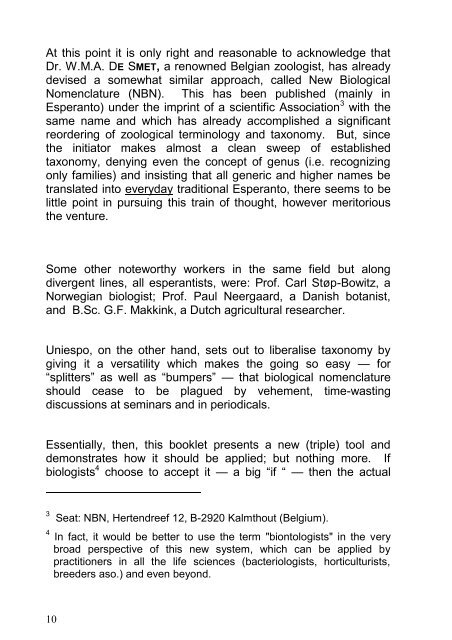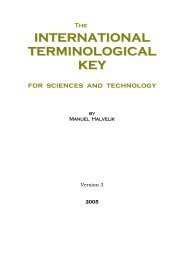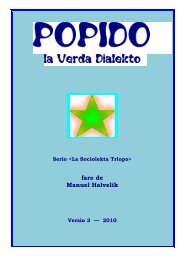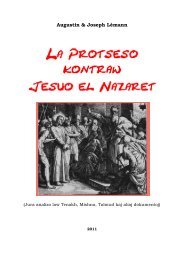the TRIMERAL SYSTEM in BIOLOGICAL TAXONOMY - universala ...
the TRIMERAL SYSTEM in BIOLOGICAL TAXONOMY - universala ...
the TRIMERAL SYSTEM in BIOLOGICAL TAXONOMY - universala ...
You also want an ePaper? Increase the reach of your titles
YUMPU automatically turns print PDFs into web optimized ePapers that Google loves.
At this po<strong>in</strong>t it is only right and reasonable to acknowledge that<br />
Dr. W.M.A. DE SMET, a renowned Belgian zoologist, has already<br />
devised a somewhat similar approach, called New Biological<br />
Nomenclature (NBN). This has been published (ma<strong>in</strong>ly <strong>in</strong><br />
Esperanto) under <strong>the</strong> impr<strong>in</strong>t of a scientific Association 3 with <strong>the</strong><br />
same name and which has already accomplished a significant<br />
reorder<strong>in</strong>g of zoological term<strong>in</strong>ology and taxonomy. But, s<strong>in</strong>ce<br />
<strong>the</strong> <strong>in</strong>itiator makes almost a clean sweep of established<br />
taxonomy, deny<strong>in</strong>g even <strong>the</strong> concept of genus (i.e. recogniz<strong>in</strong>g<br />
only families) and <strong>in</strong>sist<strong>in</strong>g that all generic and higher names be<br />
translated <strong>in</strong>to everyday traditional Esperanto, <strong>the</strong>re seems to be<br />
little po<strong>in</strong>t <strong>in</strong> pursu<strong>in</strong>g this tra<strong>in</strong> of thought, however meritorious<br />
<strong>the</strong> venture.<br />
Some o<strong>the</strong>r noteworthy workers <strong>in</strong> <strong>the</strong> same field but along<br />
divergent l<strong>in</strong>es, all esperantists, were: Prof. Carl Støp-Bowitz, a<br />
Norwegian biologist; Prof. Paul Neergaard, a Danish botanist,<br />
and B.Sc. G.F. Makk<strong>in</strong>k, a Dutch agricultural researcher.<br />
Uniespo, on <strong>the</strong> o<strong>the</strong>r hand, sets out to liberalise taxonomy by<br />
giv<strong>in</strong>g it a versatility which makes <strong>the</strong> go<strong>in</strong>g so easy — for<br />
“splitters” as well as “bumpers” — that biological nomenclature<br />
should cease to be plagued by vehement, time-wast<strong>in</strong>g<br />
discussions at sem<strong>in</strong>ars and <strong>in</strong> periodicals.<br />
Essentially, <strong>the</strong>n, this booklet presents a new (triple) tool and<br />
demonstrates how it should be applied; but noth<strong>in</strong>g more. If<br />
biologists 4 choose to accept it — a big “if “ — <strong>the</strong>n <strong>the</strong> actual<br />
3 Seat: NBN, Hertendreef 12, B-2920 Kalmthout (Belgium).<br />
4 In fact, it would be better to use <strong>the</strong> term "biontologists" <strong>in</strong> <strong>the</strong> very<br />
broad perspective of this new system, which can be applied by<br />
practitioners <strong>in</strong> all <strong>the</strong> life sciences (bacteriologists, horticulturists,<br />
breeders aso.) and even beyond.<br />
10






